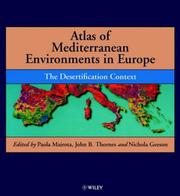| Listing 1 - 10 of 48 | << page >> |
Sort by
|
Book
ISBN: 0821314440 9780821314449 Year: 1990 Volume: 116 Publisher: Washington (D.C.): World bank,
Abstract | Keywords | Export | Availability | Bookmark
 Loading...
Loading...Choose an application
- Reference Manager
- EndNote
- RefWorks (Direct export to RefWorks)
Book
ISBN: 0931816998 9780931816994 Year: 1987 Publisher: West Hartford, CT.: Kumarian press,
Abstract | Keywords | Export | Availability | Bookmark
 Loading...
Loading...Choose an application
- Reference Manager
- EndNote
- RefWorks (Direct export to RefWorks)
Book
ISBN: 0861962613 9780861962617 Year: 1990 Publisher: Paris: Libbey,
Abstract | Keywords | Export | Availability | Bookmark
 Loading...
Loading...Choose an application
- Reference Manager
- EndNote
- RefWorks (Direct export to RefWorks)
Book
Abstract | Keywords | Export | Availability | Bookmark
 Loading...
Loading...Choose an application
- Reference Manager
- EndNote
- RefWorks (Direct export to RefWorks)
Book
ISBN: 9780691201627 0691201625 Year: 2021 Publisher: Princeton (N.J.): Princeton university press,
Abstract | Keywords | Export | Availability | Bookmark
 Loading...
Loading...Choose an application
- Reference Manager
- EndNote
- RefWorks (Direct export to RefWorks)
"The little-known history of how the Sahara was transformed from a green and fertile land into the largest hot desert in the worldThe Sahara is the largest hot desert in the world, equal in size to China or the United States. Yet, this arid expanse was once a verdant, pleasant land, fed by rivers and lakes. The Sahara sustained abundant plant and animal life, such as Nile perch, turtles, crocodiles, and hippos, and attracted prehistoric hunters and herders. What transformed this land of lakes into a sea of sands? When the Sahara Was Green describes the remarkable history of Earth's greatest desert-including why its climate changed, the impact this had on human populations, and how scientists uncovered the evidence for these extraordinary events.From the Sahara's origins as savanna woodland and grassland to its current arid incarnation, Martin Williams takes us on a vivid journey through time. He describes how the desert's ancient rocks were first fashioned, how dinosaurs roamed freely across the land, and how it was later covered in tall trees. Along the way, Williams addresses many questions: Why was the Sahara previously much wetter, and will it be so again? Did humans contribute to its desertification? What was the impact of extreme climatic episodes-such as prolonged droughts-upon the Sahara's geology, ecology, and inhabitants? Williams also shows how plants, animals, and humans have adapted to the Sahara and what lessons we might learn for living in harmony with the harshest, driest conditions in an ever-changing global environment.A valuable look at how an iconic region has changed over millions of years, When the Sahara Was Green reveals the desert's surprising past to reflect on its present, as well as its possible future"--
Book
ISBN: 0470235470 9780340632178 0340632178 9780470235478 Year: 1996 Publisher: London: Edward Arnold,
Abstract | Keywords | Export | Availability | Bookmark
 Loading...
Loading...Choose an application
- Reference Manager
- EndNote
- RefWorks (Direct export to RefWorks)
Desertification --- Climatology --- Climatology. --- Desertification. --- Geografie --- Landschapskunde --- Milieu en ecologie.
Map
ISBN: 9279753509 9789279753503 Year: 2018 Publisher: Luxembourg: Publications office of the European Union,
Abstract | Keywords | Export | Availability | Bookmark
 Loading...
Loading...Choose an application
- Reference Manager
- EndNote
- RefWorks (Direct export to RefWorks)
Book
ISBN: 9282890031 9789282890035 Year: 1986 Volume: 19390 Publisher: Bruxelles: European Commission,
Abstract | Keywords | Export | Availability | Bookmark
 Loading...
Loading...Choose an application
- Reference Manager
- EndNote
- RefWorks (Direct export to RefWorks)
Desert soils --- Desertification --- Congresses --- Desertification - Europe - Congresses --- Desert soils - Europe - Congresses

ISBN: 0471960926 9780471960928 Year: 1998 Publisher: Chichester : Wiley,
Abstract | Keywords | Export | Availability | Bookmark
 Loading...
Loading...Choose an application
- Reference Manager
- EndNote
- RefWorks (Direct export to RefWorks)
The Mediterranean countries of Europe have been undergoing rapid change and development over the last thirty years and especially during the last ten. These changes have occurred in all aspects of life and livelihood, and for many countries such change has had far reaching social and economic impacts. In addition, the results of centuries of distinctive man environment relationships in a climatically marginal region have been swept aside and the landscape itself is undergoing a rapid transformation. Large areas are being abandoned temporarily or permanently by rural populations; urban growth is rampant; agriculture has been intensified; and water scarcity, fed by the severe droughts of the 1980s and 1990s, has become a major environmental and resource concern. At the same time the threat of global climate change and the indication of deeper and more sustained future droughts has brought these issues into sharp focus. Based on the findings of the European Communitys Medalus Project, this Atlas brings to a wide audience the background to and a contemporary understanding of the environmental crisis, which is now facing the Mediterranean region of Europe, as well as the future prospects for a solution.

ISBN: 2760508889 9782760508880 Year: 1996 Publisher: Sainte-Foy: Presses de l'Université du Québec,
Abstract | Keywords | Export | Availability | Bookmark
 Loading...
Loading...Choose an application
- Reference Manager
- EndNote
- RefWorks (Direct export to RefWorks)
Remote sensing --- Geology --- Geomorphology --- Water quality --- biomass --- Végétation --- vegetation --- marine ecology --- Désertification --- Desertification --- land use --- urban areas --- Rural areas --- Natural resources --- resource management --- vegetation. --- Desertification.
| Listing 1 - 10 of 48 | << page >> |
Sort by
|

 Search
Search Feedback
Feedback About UniCat
About UniCat  Help
Help News
News